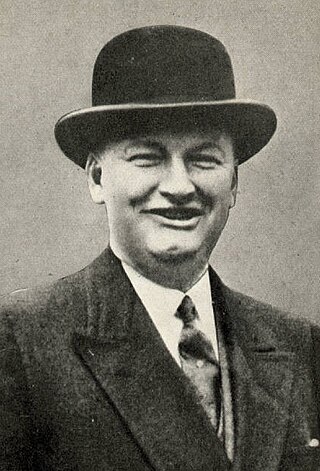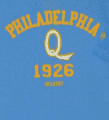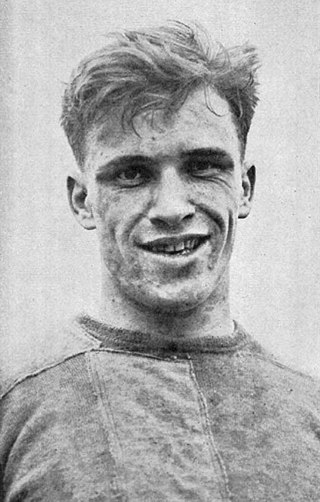
The All-America Football Conference (AAFC) was a major professional American football league that challenged the established National Football League (NFL) from 1946 to 1949. One of the NFL's most formidable challengers, the AAFC attracted many of the nation's best players, and introduced many lasting innovations to the game. However, the AAFC was ultimately unable to sustain itself in competition with the NFL. After it folded, three of its teams were admitted to the NFL: the San Francisco 49ers, the Cleveland Browns and the original Baltimore Colts.

The Los Angeles Buccaneers were a traveling team in the National Football League during the 1926 season, ostensibly representing the city of Los Angeles, California. Like the Los Angeles Wildcats of the first American Football League, the team never actually played a league game in Los Angeles. It was operated out of Chicago with players from California colleges.
The New York Yankees were a short-lived professional American football team from 1926 to 1929. The team was a member of the first American Football League in 1926, and later the National Football League from 1927 to 1929. They played their home games at Yankee Stadium. The team featured Red Grange at halfback.

The Rock Island Independents were a professional American football team, based in Rock Island, Illinois, from 1907 to 1926. The Independents were a founding National Football League franchise. They hosted what has been retrospectively designated the first National Football League game on September 26, 1920 at Douglas Park. The Independents were founded in 1907 by Demetrius Clements as an independent football club. Hence, the team was named the "Independents."

Harold Edward "Red" Grange, nicknamed "the Galloping Ghost" and "the Wheaton Iceman", was an American professional football halfback who played for the Chicago Bears and the short-lived New York Yankees. His signing with the Bears helped legitimize the National Football League (NFL).

Timothy James Mara was the founding owner of the New York Giants of the National Football League (NFL). The Giants, under Mara, won NFL championships in 1927, 1934, 1938, and 1956 and divisional titles in 1933, 1935, 1939, 1941, 1944, 1946, and 1958.

The Philadelphia Quakers were a professional American football team that competed in the first American Football League in 1926 and won the league's only championship.
The 1925 Chicago Bears season was their sixth regular season completed in the National Football League. The team was unable to improve on their 6–1–4 record from 1924 and finished with a 9–5–3 record under head coach George Halas earning them a seventh-place finish in the team standings, their worst showing to that date. However, the 1925 Bears were the most notable team in the young NFL's history to that point all because of the addition of college players, including Red Grange.
The first American Football League (AFL), sometimes called AFL I, AFLG, or the Grange League, was a professional American football league that operated in 1926. It was the first major competitor to the National Football League (NFL). Founded by Charles "C.C." Pyle, (1882–1939), and General Charles X. Zimmerman, (1865–1926), as vice president and starring Hall of Fame halfback Harold Edward "Red" Grange, (1903–1991), the short-lived league with nine teams competed against the more established – then six-year-old – NFL, both for players and for fans. While Pyle's and Grange's New York Yankees team and the already established Philadelphia Quakers became reliable draws, the lack of star power and the uncertain financial conditions of the other seven teams led to the league's dissolution after one season.
The Boston Bulldogs were a professional American football team that competed in the first American Football League in 1926. Owned by Robert McKirby, the Bulldogs lasted only six games into the AFL season, playing one home game in Braves Field and one in Fenway Park. Coached by player-coach Herb Treat, the majority of the team played their college football in New England, Pennsylvania, and New York. The offense led by Joe McGlone was inconsistent, scoring a total of 20 points in its existence… 17 of which were tallied in one game. Erwin Gehrke and Carl Etelman shared the kicking duties. Bill Cronin, a tailback, scored the team's only offensive touchdown.

George Schly "Wildcat" Wilson was an American football player. After earning consensus All-American honors in 1925 as a halfback for the University of Washington, he played professionally, including three seasons in the National Football League (NFL). Listed at 5 feet 10+1⁄2 inches (1.791 m) and 185 pounds (84 kg), he was inducted to the College Football Hall of Fame in 1951.
The American Football League (AFL) was a professional American football league that operated in 1936 and 1937. The AFL operated in direct competition with the more established National Football League (NFL) throughout its existence. While the American media generally ignored its operation, this second AFL was the first "home" of the Cleveland Rams, which joined the National Football League after one year in the AFL.
The 1926 AFL season is the only season of the first American Football League. It started with nine teams, with the initial game of the season being played in front of 22,000 fans in Cleveland, Ohio, but by the end of the season, only four teams were still in existence: three teams owned or subsidized by league founder C. C. Pyle and star Red Grange and league champion Philadelphia Quakers. The initial lineup of teams included the traveling Wildcats and a charter member of the National Football League, the Rock Island Independents, which became a second traveling team after having poor attendance in its first three games.

Charles C. "Charlie" Pyle, sometimes called "Cash and Carry Pyle," was a Champaign–Urbana, Illinois theater owner, sports agent, and sports entreprenuer best known for his representation of American football star Red Grange and French tennis player Suzanne Lenglen.
The Pacific Coast Professional Football League (PCPFL), also known as the Pacific Coast Football League (PCFL) and Pacific Coast League (PCL) was a professional American football minor league based in California. It operated from 1940 through 1948. One of the few minor American professional sports leagues that competed in the years of World War II, the PCPFL was regarded as a minor league of the highest level, particularly from 1940 to 1945, at a time in which the National Football League (NFL) did not extend further west than Chicago and Green Bay. It was also the first professional football league to have a team based in Hawaii.
In professional team sports, a traveling team is a member of a professional league that never competes in its home arena or stadium. This differs from a barnstorming team as a barnstorming team competes in exhibition games and not within a league or association framework as a traveling team does. While leagues may designate a traveling team prior to the start of competition, some teams become road teams by simply not scheduling any home games.
The Cleveland Panthers were a professional American football team. They were an independent team founded in 1919 from the remains of the Youngstown Patricians. The Panthers played, with various degrees of success, continuously from 1919 and eventually, as fewer opponents played them each year after 1926, sputtered to a quiet folding in 1933.
The Chicago Bulls were a professional American football team that competed in the first American Football League in 1926. Owned by Joey Sternaman, the Bulls also had AFL founders C. C. Pyle and Red Grange as shareholders. Joey Sternaman was also the coach and blocking back for the Bulls throughout their brief existence.
Matthew A. Bross was an American football back for the Los Angeles Wildcats of the American Football League (AFL) and the Green Bay Packers of the National Football League (NFL). He played college football for Gonzaga.
The Brooklyn Lions were a National Football League team that played in the 1926 NFL season. The team was formed as the league's counter-move to the first American Football League, which enfranchised a team called the Brooklyn Horsemen, a professional football team that competed in the 1926 AFL season.









